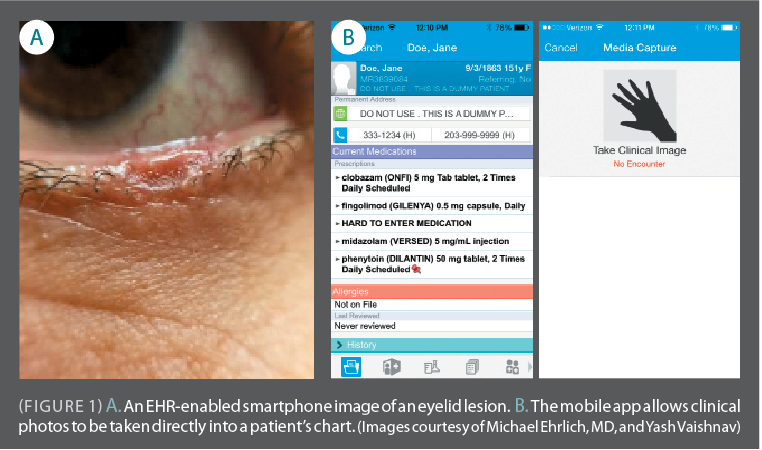Article
Mobile EHR photos brings instant visualization of clinical images
Author(s):
Capturing clinical images with the integration of electronic health records and smartphone applications can enhance practice efficiency and compliance.
Take-home message: Capturing clinical images with the integration of electronic health records and smartphone applications can enhance practice efficiency and compliance.
Plastics Pearls By Michael Ehrlich, MD, and Yash Vaishnav
Ophthalmologists and oculoplastic surgeons frequently take external photographs for documentation of lesions and perioperative before-and-after images. The integration of mobile electronic health record (EHR) technology means that the digital camera might be relegated to the storage closet along with the instant-picture (Polaroid) camera.
The old way
Many practices rely on a separate digital camera for external photographs, which then are transferred to a separate computer where they are printed or scanned into the patients’ charts. The process can be time consuming for both the physicians and staff.
This approach can also be expensive and rife with potential problems. A digital-SLR camera and lenses can cost $1,000. Imagine the Health Insurance Portability and Accountability Act (HIPAA) violation if the camera’s storage card is lost. How secure is the computer and program where photos are stored and backed up? Will the next computer upgrade support the photo program the practice has been using since 1998?
The new way
The integration of EHR systems in daily practice has been concurrent with the adoption of smartphones in the hands of physicians. Three out of four physicians who use an EHR also use a smartphone, according to the 2013 Mobile Usage in the Medical Space Report (http://mhealth.jmir.org/2015/1/e1/).

This number has likely increased and many EHR companies have subsequently developed smartphone apps that integrate directly into the EHR. Though these apps can be helpful when away from the office, taking clinical photos within these applications greatly increases efficiency and compliance.
The outpatient clinical practice at Yale Eye Center, New Haven, CT, uses a certain hospital EHR platform (Epic, Epic Systems). Its mobile app (Haiku, Epic Systems) allows clinical photos to be taken directly into a patient’s chart (Figure 1 and 2).
These photos-which are not stored on the smartphone itself-are time- and date-stamped and cannot be touched-up. Any data transferred to/from the server is Secure Sockets Layer-encrypted and requires two-factor authentication-the latter of which is built into the app. The mobile app is device-specific and creates an alert and audit trail if a protected chart is accessed.
For patients, this high-tech process allows immediate visualization of images on the larger, in-room computer screen where most EHR data in entered. In addition, patients can be shown before-and-after photos quickly.
For the team of surgical schedulers, photos and chart are immediately ready to be sent for any needed insurance approval.
This approach requires little EHR familiarity, making it ideal for widespread use. Physicians can choose to continue to take all of their photos themselves or a scribe could be taught the process easily.
Limitations
While the potential photo quality of a digital SLR still exceeds that of an iPhone 6, the resolution has been found to be adequate for clinical, teaching, and presentation purposes.
One area where a smartphone cannot match a digital SLR, however, is macro photography of an eyelid or conjunctival lesion. Experimenting with various clip-on macro lenses may alleviate this issue, and the Mpow macro clip-on lens is a worthwhile $15 investment to document these small lesions.
Michael Ehrlich, MD, is assistant professor of ophthalmology, Oculoplastics and Orbital Surgery, Yale Eye Center, New Haven, CT.
Yash Vaishnav is a medical student, Frank Netter School of Medicine, New Haven, CT.
Newsletter
Don’t miss out—get Ophthalmology Times updates on the latest clinical advancements and expert interviews, straight to your inbox.




